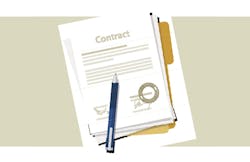Ten years ago, a work authorization form saved Truman Fancher III nearly $4,000 at his shop, Truman Fancher Auto Collision Repair in Pelham, Ala. The issue began when Allstate was willing to reimburse for a used frame for a repair, but Fancher and the customer refused and terminated the job.
Fancher produced a $4,000 invoice for the work, storage, admin and all other charges at the time and sent a written termination notice to the customer via email, and copied Allstate. Although Allstate did try to delay the process, the situation was resolved quickly because of one piece of paper: a work authorization contract.
Based on the terms of Fancher’s termination clause in his contract, he was legally allowed to bill for the repair that was ultimately terminated. Without it, he’d probably still be waiting for payment today.
Fancher doesn’t beat around the bush when it comes to shops who don’t have work authorization contracts:
“It’s foolish. Simply foolish,” he says.
Tony Lombardozzi echoes that sentiment. As the president for the Coalition of Collision Repair Excellence (CCRE) and co-founder of Superare Marketing + Advertising, he says that for 25 years, he’s been trying to preach that “contract is the way to go.”
Lombardozzi says if you’re ever involved in a court case, the judge will ask for evidence of documentation. A simple signature on the form does wonders, as it documents that you advised the customer on the process.
The days of the standard, few-paragraph authorization form are over. With vehicles containing more data and customer information than ever, these forms have become crucial to avoiding combative situations with customers—and even lawsuits. As pre- and post-repair diagnostic scanning has become increasingly required by OEs, shops need authorization to release scan data to third parties, such as insurance carriers, and failure to obtain that authorization means your shop could be held responsible.
Both Fancher and Lombardozzi share their secrets on how to build a strong work authorization contract.
What Should a Contract Look Like?
The purpose of the contract is to explain what the seller and the buyer’s responsibilities are. As Lombardozzi puts it, that is exactly what body shops are missing. The forms simply say, “Go ahead and fix my car.”
There are many components one can include in a form, depending on company policies, state laws and other variables. Lombardozzi says when it comes time to write your contract, have it written or looked over by an attorney to ensure the contract is written according to local and state laws.
You need to have a contract whether you are a DRP shop or not, but you may need to re-evaluate what is included in your contract if you are a DRP shop.
Lombardozzi says that under a DRP contract, the insurer becomes the general contractor while the shop becomes a subcontractor. As a subcontractor, it is likely the shop has signed a “hold harmless agreement,” which negates a contract.
If this is the case, the shop would have to run the contract by the insurer and certain things would have to be removed, such as “termination of repair and expectancy to damages.”
After outlining the shop and the vehicle owner’s responsibilities, Lombardozzi says these are seven highlights that should be included in every contract:
-
Authorization. While you’re not creating a classic “work authorization form,” you still need to get authorization from your customer. You need the customer to agree that your body shop will repair the vehicle.
-
Waivers of Estimates. Some states have waivers. If your state qualifies, add that in.
-
Parts. Depending on the state, Lombardozzi says that some states give the owner of the vehicle the right to either keep the parts or look at them and then destroy them.
If this applies to you, just provide a box that specifies “you’d like to keep the parts.” Then they can check and initial the box.
-
Customer Responsibility. What is the customer responsible for at the completion of repairs? It’s in this section, you can include the payment types you accept and make clear whether the owner is ultimately responsible for payment.
-
The Repair Process. The estimate, blueprint or damage analysis needs to be explained and attached to the contract.
-
Precession and Replevin. For most of the shops Lombardozzi works with, he recommends adding a “precession and replevin.”
In some rare cases in which a body shop holds onto a vehicle for payment, the insurer of the vehicle owner can get a court order which is called a “replevin.”
They can put up a bond and the body shop has to release the vehicle whether payment is obtained or not. Adding this can prevent that.
-
The Right to Expectancy of Damages and Termination of Repairs. This is one of the crucial keys to any work authorization contract, he says.
What happens if you can’t agree as to whether the insurer will pick up the bill or the owner will pay a portion. If, for any reason, you had to terminate the repair, you have an expectancy of damages.
For example, if an insurance company convinces a vehicle owner to remove a vehicle halfway through disassembly, you won’t get any money. Not only that, but unless it’s written in the form, you will not have any basis in court, if necessary.
In Fancher’s form, it lays out the potential charges if the owner decides to terminate the repair. (See Sidebar: “Francher’s One-Page Contract”)
It may prove useful to add additional clauses, such as not being responsible for damages that occur from natural disaster like tornadoes or floods, Lombardozzi says.
8. The Right to Refuse Repair Procedures, Techniques or Installation of Certain Parts. If the insurer doesn’t want to pay for certain procedures that need to be done, your customer should understand he or she is responsible for those charges.
Include Pre- and Post-Repair Scanning
You should specify that you will repair the car to manufacturer specifications. If the specification claims scanning is necessary, then it’s included in the repair process.
When it comes to the information obtained from scanning, Lombardozzi says scans performed on the vehicle are proprietary information between you and the owner of the vehicle.
For example, when a vehicle is scanned and multiple codes come up, it is the repairer’s job to clear codes unrelated to the accident. Explain to your customer that the insurer may not pay for some of those repairs, if they were unrelated.
Do not give scans to insurers without the customer’s permission. Instead, tell the insurer you cannot disclose that information. If the customer is OK with sharing the information, make sure to document it. Send the customer an email or text and get a reply.
Truman Fancher’s One-Page Contract
—
Writing his own contract, Truman Fancher had it read by his attorney and approved. Going for a simplistic approach, Fancher's contract covers all of his bases.
- Header. “I, the undersigned, hereby authorize X Body Shop to disassemble, inspect and blueprint the repair process …”
- Guarantee of Payment. This section outlines the vehicle owner is solely responsible for the payment of the repairs.
- Limited Power of Attorney.
- First Party Clainments Only. Repair times cannot always be guaranteed to be within policy limits.
- Hold Harmless.
- Collections.
- Repair Contract Termination.
- Signature and Date.

